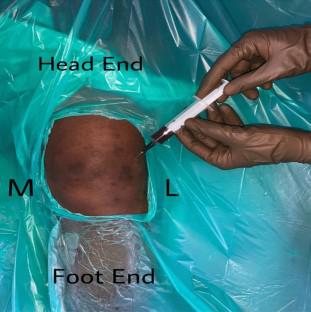Indian Journal of Orthopaedics ( IF 1.1 ) Pub Date : 2022-09-16 , DOI: 10.1007/s43465-022-00745-x Abhishek Kumar Rai 1 , Shubhranshu Shekhar Mohanty 1 , Tushar Narayan Rathod 1 , Prashant Kamble 1 , Swapnil Anil Keny 1 , Ronak Ashok Kothari 1

|
Background
Bleeding into the joints cause major morbidity in haemophilia patients. The clinical hallmark of haemophilia is haemarthrosis especially in knee, ankle and elbow joint. Current literature suggests that aspiration of an acute haemarthrosis in haemophilia may lead to further bleeding and prevent tamponade effect. But the rehabilitation gets delayed, leading to joint stiffness and the function gets deteriorated. This study was done to evaluate the efficacy of joint aspiration in the management of acute knee haemarthrosis, with regard to pain relief and functional outcome.
Materials and Methods
This is a prospective, randomised controlled trial in a tertiary care haemophilia treatment centre comprising 120 haemophilic patients with unilateral acute knee haemarthrosis. Factor level was checked and appropriate factor replacement [40%] was done. The patients were randomly allocated in two groups: Group A and Group B, each consisting of 60 patients. All patients received ice application, limb immobilisation, analgesics, physiotherapy and compression bandage as the routine primary management. In addition, study Group A also received therapeutic aspiration of the knee joint at initial presentation, after the first factor infusion. All patients were clinically evaluated for pain in terms of Visual Analogue Scale (VAS score) and function in terms of Haemophilic Joint Health Score [HJHS], before and at 4 h, 48 h and 7 days after initial factor administration.
Results
All patients showed therapeutic improvement in terms of a declining trend in VAS and HJHS scores. Pain relief (VAS Score) in Group A, was found to be significantly better compared to Group B at the end of 4 h [4.80 ± 0.49 vs 6.54 ± 1.05; p < 0.001], 48 h [2.48 ± 0.50 vs 3.30 ± 0.46; p < 0.001] and 7 days [1.16 ± 0.37 vs 1.70 ± 0.46; p < 0.001]. Functional improvement (HJHS Score) in Group A, was found to be significantly better compared to Group B as well at the end of 4 h [11.24 ± 0.77 vs 14.52 ± 0.61; p < 0.001], 48 h [7.24 ± 0.65 vs 11.28 ± 0.64; p < 0.001] and 7 days [2.36 ± 0.48 vs 5.52 ± 0.67; p < 0.001].
Conclusion
Our study recommends the use of joint aspiration as a therapeutic tool in the holistic management of acute knee haemarthrosis in addition to usual treatment of ice application, immobilization and oral tranexamic acid. Early factor replacement along with therapeutic joint aspiration is a key for better pain relief and a better functional outcome.
中文翻译:

血友病关节急性膝关节血肿的关节抽吸结果:在三级血友病护理中心对 120 名患者进行的前瞻性随机对照试验
背景
关节出血导致血友病患者发病率较高。血友病的临床特征是关节积血,尤其是膝关节、踝关节和肘关节。目前的文献表明,血友病急性关节积血的抽吸可能会导致进一步出血并防止填塞效应。但康复会延迟,导致关节僵硬、功能恶化。本研究旨在评估关节抽吸术在治疗急性膝关节积血方面的功效,包括疼痛缓解和功能结果。
材料和方法
这是一项在三级血友病治疗中心进行的前瞻性、随机对照试验,该试验由 120 名患有单侧急性膝关节积血的血友病患者组成。检查因素水平并进行适当的因素替换[40%]。患者被随机分为两组:A 组和 B 组,每组 60 名患者。所有患者均接受冰敷、肢体固定、镇痛药、物理治疗和加压绷带作为常规主要治疗。此外,研究 A 组还在首次因子输注后首次就诊时接受了膝关节的治疗性抽吸。在初始因子施用之前和之后 4 小时、48 小时和 7 天,对所有患者进行视觉模拟量表(VAS 评分)方面的疼痛临床评估,以及血友病关节健康评分 [HJHS] 方面的功能临床评估。
结果
所有患者的 VAS 和 HJHS 评分均呈下降趋势,治疗效果有所改善。4 小时结束时,A 组的疼痛缓解(VAS 评分)明显优于 B 组 [4.80 ± 0.49 vs 6.54 ± 1.05;p < 0.001],48 小时 [2.48 ± 0.50 与 3.30 ± 0.46;p < 0.001] 和 7 天 [1.16 ± 0.37 与 1.70 ± 0.46;p < 0.001]。4 小时结束时,A 组的功能改善(HJHS 评分)也明显优于 B 组 [11.24 ± 0.77 vs 14.52 ± 0.61;p < 0.001],48 小时 [7.24 ± 0.65 与 11.28 ± 0.64;p < 0.001] 和 7 天 [2.36 ± 0.48 vs 5.52 ± 0.67;p < 0.001]。
结论
我们的研究建议,除了常规的冰敷、固定和口服氨甲环酸治疗外,还建议使用关节抽吸作为急性膝关节积血整体治疗的治疗工具。早期因子替代和治疗性关节抽吸是更好地缓解疼痛和更好的功能结果的关键。











































 京公网安备 11010802027423号
京公网安备 11010802027423号